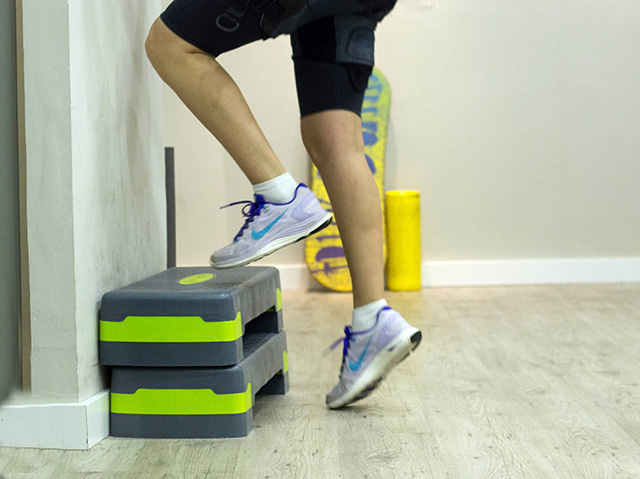The Harvard Step test is a test of aerobic fitness, developed by Brouha et al. (1943) in the Harvard Fatigue Laboratories during WWII. The features of this test is that it is simple to conduct and requires minimal equipment. Participants step at a rate of 30 steps per minute for 5 minutes or until exhaustion. There are many other variations of step tests too.
equipment required: step or platform 20 inches (50.8 cm) high for men, 40 cm (16 inches) for women, stopwatch, metronome or cadence tape.
pre-test: Explain the test procedures to the subject. Perform screening of health risks and obtain informed consent. Prepare forms and record basic information such as age, height, body weight, gender, test conditions. Check step height and set metronome. See more details of pre-test procedures.
procedure: The athlete steps up and down on the platform at a rate of 30 steps per minute (every two seconds) for 5 minutes or until exhaustion. Exhaustion is defined as when the athlete cannot maintain the stepping rate for 15 seconds. The athlete immediately sits down on completion of the test, and the total number of heart beats are counted between 1 to 1.5 minutes after finishing (see measuring heart rate). This is the only measure required if using the short form of the test. If the long form of the test is being conducted, there is an additional heart rate measures at between 2 to 2.5 minutes, and between 3 to 3.5 minutes. See some videos of Harvard Step tests being performed.
 step-up testing
step-up testingscoring: the Fitness Index score is determined by the following equations. For example, if the total test time was 300 seconds (if completed the whole 5 minutes), and the number of heart beats between 1-1.5 minutes was 90, between 2-2.5 it was 80 and between 3-3.5 it was 70, then the long form Fitness Index score would be: (100 x 300) / (240 x 2) = 62.5. Note: you are using the total number of heart beats in the 30 second period, not the rate (beats per minute) during that time.
Fitness Index (short form) = (100 x test duration in seconds) divided by (5.5 x pulse count between 1 and 1.5 minutes).
Fitness Index (long form) = (100 x test duration in seconds) divided by (2 x sum of heart beats in the recovery periods).
| rating | fitness index (long form) |
|---|---|
| excellent | > 96 |
| good | 83 - 96 |
| average | 68 - 82 |
| low average | 54 - 67 |
| poor | < 54 |
validity: correlation to VO2max has been reported as between 0.6 to 0.8 in numerous studies.
advantages: This test requires minimal equipment and costs, and can be self-administered.
disadvantages: Biomechanical characteristics vary between individuals. For example, considering that the step height is standard, taller people are at an advantage as it will take less energy to step up onto the step. Body weight has also been shown to be a factor. Testing large groups with this test will be time consuming.
comments: The Harvard Step Test was developed by Brouha et al. (1943) in the Harvard Fatigue Laboratories during WWII. Some sources suggest a 40 cm high bench, which is not the standard and original bench height. Since the original description of this test, there have been variations in the test procedure such as reducing the bench height for female participants in some research studies. Also be aware that I have noticed that some websites incorrectly list the formula for the long form without doubling the denominator. What is listed here has been confirmed as the correct formula.
references (in chronological order):
- Brouha L, Health CW, Graybiel A. Step test simple method of measuring physical fitness for hard muscular work in adult men. Rev Canadian Biol, 1943 ;2:86
- Fox, E.L., Billings, C.E., Bartels, R.L. et al. Fitness standards for male college students. Int. Z. Angew. Physiol. Einschl. Arbeitsphysiol. 31, 231–236 (1973).
- KEEN EN, SLOAN AW. Observations on the Harvard step test. J Appl Physiol. 1958 Sep;13(2):241-3.
- Meyers CR., A study of the reliability of the Harvard step test. Res Q. 1969 May; 40(2): 423.
- MONTOYE HJ. The Harvard step test and work capacity. Rev Can Biol. 1953 Mar;11(5):491-9.
- Montoye HJ, Willis PW 3rd, Cunningham DA, Keller JB. Heart rate response to a modified Harvard step test: males and females, age 10-69. Res Q. 1969 Mar;40(1):153-62.
- REEDY JD, SAIGER GL, HOSLER RH. Evaluation of the Harvard Step Test with respect to factors of height and weight. Int Z Angew Physiol. 1958;17(2):115-9.
- Ricci B, Baldwin K, Hakes R, Fein J, Sadowsky D, Tufts S, Wells C., Energy cost and efficiency of Harvard step-test performance. Int Z Angew Physiol. 1966 Apr 28;22(2):125-30.
- RYHMING I. A modified Harvard step test for the evaluation of physical fitness. Arbeitsphysiologie. 1953;15(3):235-50.
- Sloan AW., A modified Harvard step test for women. J Appl Physiol. 1959 Nov;14:985-6.
Similar Tests
- General Step Test procedure, and links to other step tests.
Related Pages
- Video of the Harvard Step test being performed.
- About a Step Test iphone app
- List of all fitness tests
- Step-up exercises at the beach or during pregnancy
- More information on measuring heart rate


 Current Events
Current Events